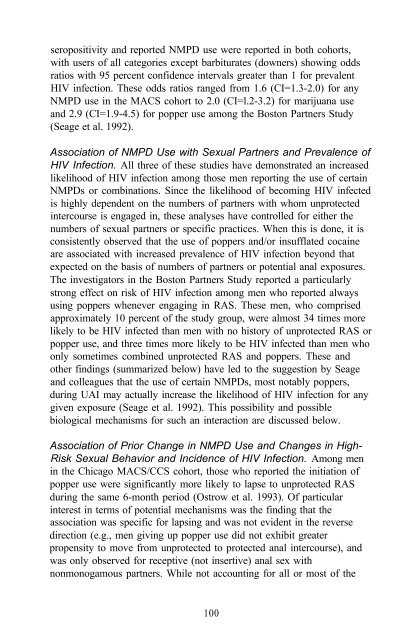The Context of HIV Risk Among Drug Users and Their Sexual Partners
The Context of HIV Risk Among Drug Users and Their Sexual Partners
The Context of HIV Risk Among Drug Users and Their Sexual Partners
Create successful ePaper yourself
Turn your PDF publications into a flip-book with our unique Google optimized e-Paper software.
seropositivity <strong>and</strong> reported NMPD use were reported in both cohorts,<br />
with users <strong>of</strong> all categories except barbiturates (downers) showing odds<br />
ratios with 95 percent confidence intervals greater than 1 for prevalent<br />
<strong>HIV</strong> infection. <strong>The</strong>se odds ratios ranged from 1.6 (CI=1.3-2.0) for any<br />
NMPD use in the MACS cohort to 2.0 (CI=l.2-3.2) for marijuana use<br />
<strong>and</strong> 2.9 (CI=1.9-4.5) for popper use among the Boston <strong>Partners</strong> Study<br />
(Seage et al. 1992).<br />
Association <strong>of</strong> NMPD Use with <strong>Sexual</strong> <strong>Partners</strong> <strong>and</strong> Prevalence <strong>of</strong><br />
<strong>HIV</strong> Infection. All three <strong>of</strong> these studies have demonstrated an increased<br />
likelihood <strong>of</strong> <strong>HIV</strong> infection among those men reporting the use <strong>of</strong> certain<br />
NMPDs or combinations. Since the likelihood <strong>of</strong> becoming <strong>HIV</strong> infected<br />
is highly dependent on the numbers <strong>of</strong> partners with whom unprotected<br />
intercourse is engaged in, these analyses have controlled for either the<br />
numbers <strong>of</strong> sexual partners or specific practices. When this is done, it is<br />
consistently observed that the use <strong>of</strong> poppers <strong>and</strong>/or insufflated cocaine<br />
are associated with increased prevalence <strong>of</strong> <strong>HIV</strong> infection beyond that<br />
expected on the basis <strong>of</strong> numbers <strong>of</strong> partners or potential anal exposures.<br />
<strong>The</strong> investigators in the Boston <strong>Partners</strong> Study reported a particularly<br />
strong effect on risk <strong>of</strong> <strong>HIV</strong> infection among men who reported always<br />
using poppers whenever engaging in RAS. <strong>The</strong>se men, who comprised<br />
approximately 10 percent <strong>of</strong> the study group, were almost 34 times more<br />
likely to be <strong>HIV</strong> infected than men with no history <strong>of</strong> unprotected RAS or<br />
popper use, <strong>and</strong> three times more likely to be <strong>HIV</strong> infected than men who<br />
only sometimes combined unprotected RAS <strong>and</strong> poppers. <strong>The</strong>se <strong>and</strong><br />
other findings (summarized below) have led to the suggestion by Seage<br />
<strong>and</strong> colleagues that the use <strong>of</strong> certain NMPDs, most notably poppers,<br />
during UAI may actually increase the likelihood <strong>of</strong> <strong>HIV</strong> infection for any<br />
given exposure (Seage et al. 1992). This possibility <strong>and</strong> possible<br />
biological mechanisms for such an interaction are discussed below.<br />
Association <strong>of</strong> Prior Change in NMPD Use <strong>and</strong> Changes in High-<br />
<strong>Risk</strong> <strong>Sexual</strong> Behavior <strong>and</strong> Incidence <strong>of</strong> <strong>HIV</strong> Infection. <strong>Among</strong> men<br />
in the Chicago MACS/CCS cohort, those who reported the initiation <strong>of</strong><br />
popper use were significantly more likely to lapse to unprotected RAS<br />
during the same 6-month period (Ostrow et al. 1993). Of particular<br />
interest in terms <strong>of</strong> potential mechanisms was the finding that the<br />
association was specific for lapsing <strong>and</strong> was not evident in the reverse<br />
direction (e.g., men giving up popper use did not exhibit greater<br />
propensity to move from unprotected to protected anal intercourse), <strong>and</strong><br />
was only observed for receptive (not insertive) anal sex with<br />
nonmonogamous partners. While not accounting for all or most <strong>of</strong> the<br />
100
















